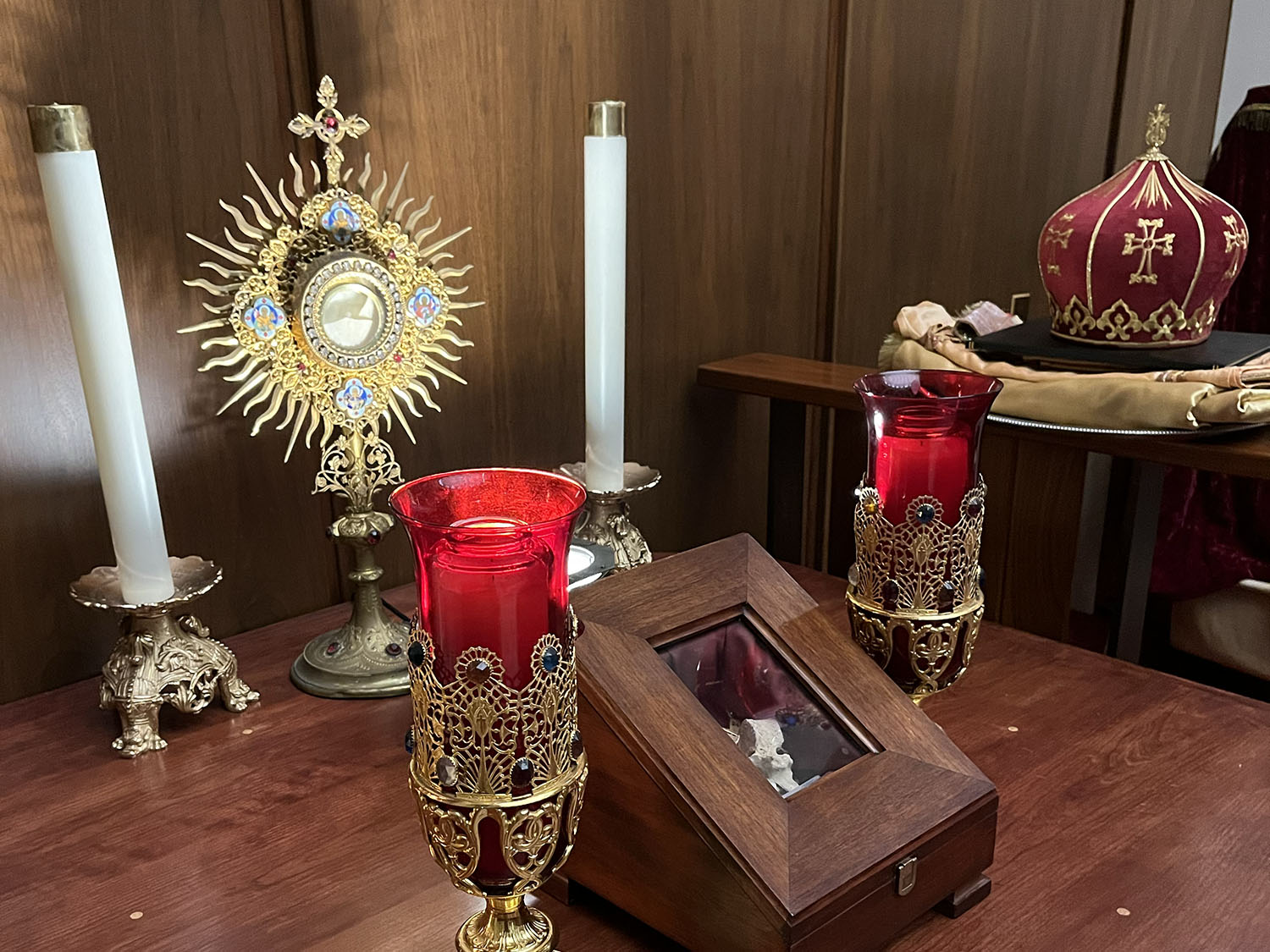Divine Liturgy
Labor Day to Memorial Day begins 9:45am
Memorial Day to Labor Day begins 9:30am (Summer Hours)
The Divine Liturgy is the main worship service of the Armenian Church. But the Badarak, as we call it in Armenian, is much more than that. It provides the most intimate encounter we can have with God in this life. In the Divine Liturgy, Jesus Christ, the Son of God, comes to his people—to you and me—in two forms: First, by his Word, in the reading of the holy Gospel; and second, by his holy Body and Blood, in Holy Communion. These two actions—the reading of the Word of God, and the reception of Holy Communion—are the two pillars or building blocks of the Divine Liturgy in all ancient, apostolic churches.
Supported by these two pillars is a magnificent structure of words, music, symbols, and rituals. For those unfamiliar with it, the Divine Liturgy can seem like a bewildering array of disjointed movements and rituals, and arcane theological terminology. The complex interplay of the celebrant priest, the deacons, the other altar servers, the choir, and the people might lead one to overlook the logic and purpose of the Divine Liturgy, and to miss its very real benefits.
Back in the 10th century, the great Armenian theologian Khosrov Antsevatsi eloquently described the importance of the Divine Liturgy when he wrote: “Since those who confess and show repentance receive atonement by means of the Holy Mystery [the Badarak], and are reunited to Christ in order to become for Him Body and members, we should be eager for the great medicine.” The Divine Liturgy is the great medicine that provides true meaning and direction for our lives. It offers the peace and solace that only God can give—a free gift no less—in an age when so many people are searching, and spending millions of dollars in vain to find personal stability and security.
The Badarak really is a matter of life and death. This guide to the Divine Liturgy of the Armenian Church is something like a travelogue that leads you on your journey, supplying helpful information about points of interest along the way. It is designed to accompany the new Divine Liturgy “Pew Book,” The Divine Liturgy of the Armenian Church: With Modern Armenian and English Translations, Transliteration, Musical Notation, Introduction and Notes (New York: St. Vartan Press, 1999). Page numbers from the Pew Book have been placed in square brackets [ ] for easy cross-reference. While it will not answer all your questions, this booklet will help you to discover the larger themes that unite the words, music, and rituals of the Badarak. In this way, it is hoped, you will be drawn into deeper and more meaningful participation in the Divine Liturgy.
(source: www.armenianchurch-ed.net)
GUIDE TO PARTICIPATING IN THE DIVINE LITURGY
WHEN TO MAKE THE SIGN OF THE CROSS. The sign of the cross is made when entering the Church and on these occasions during the Divine Liturgy:
- after each instance of bowing
- when doxology (Park Hor…), that is to say, “Glory to the Father and to the Son and to the Holy Spirit” is being said or sung
- when the Sacred name of our Lord is being solemnly invoked (Hisoos Krisdos)
- at the beginning of the reading of the Gospel
- when peace or blessing is being offered by the priest with the words “Peace unto all” (Khaghaghootune Amenetsoon)
- when the priest or deacon swing the censor in your direction
- when the sacred and the central words of the Divine Liturgy are being spoken (“Take, eat, this is My Body…” and “Drink ye all, this is My Blood.”)
- when receiving Holy Communion
- when kissing the Gospel and leaving the Church.
Response when Kissing the Cross (during the procession):
The faithful say:
- Յիշեսջիր եւ զիս առաջի անմահ գարինն Աստուծոյ:
- Hee-shes-cheer yev zeez a-rra-chee an-mah Karinn As-doo-dzo
- Remember me before the immortal Lamb of God.)
The priest says:
- Յիշեալ լիջիր առաջի անմահ գարինն Աստուծոյ:
- Hee-shyal lee-cheer a-rra-chee an-mah ka-rinn As-doo-dzo
- You shall be remembered before the immortal Lamb of God.)
Response for the Kiss of Peace:
The giver says:
- Քրիստոս ի մէջ մեռ յայտնեցաւ:
- Krees-dos ee mech mer hayd-ne-tsav.
- Christ is revealed in our midst.
The receiver says:
- Օրհնեալ է յայտնութիւնն Քրիստոսի:
- Orh-nyal eh hayd-noo-tyoo-nun Krees-do-see.
- Blessed is the revelation of Christ.
Response when Kissing the Gospel (after the Divine Liturgy):
The faithful say:
- Յիշեսցէ Տէր զամենայն պատարաքս քո:
- Hee-shes-tseh Der za-me-nayn ba-da-ra-kus ko.
- May the Lord remember all your sacrifices.
The priest says:
- Տացէ քեզ Տէր ըստ սրտի քում:
- Da-tseh kez Der usd-sur-dee koom.
- May the Lord grant to you according to your heart.
Participating in the Divine Liturgy: Please follow the prayers and hymns of the Divine Liturgy in the books provided in the pews. The first half contains the Armenian (Krapar) text and modern Armenian translation, while the second half provides the English transliteration and translation. Page numbers are illuminated at the upper left side of the main altar. Please sing along with the hymns the choir is singing.

